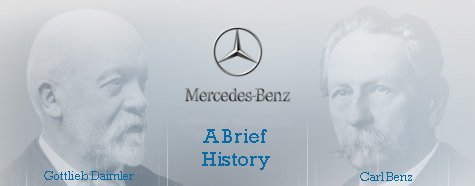
In 1885 the townspeople of Cannstatt, Germany, were startled to see Paul Daimler, son of Gottlieb Daimler, roll away from No.14 Taubenheimstrasse on a wooden-spoked two-wheeler powered by a fraction of a horsepower four-cycle internal combustion engine. That belt driven motorcycle (actually a four-wheeler as it had two eight-inch diameter outrigger wheels to keep it stable when at a standstill) was the forerunner of all automobiles.
Gottlieb Daimler was the first man to harness with any true degree of success a combustion engine into a road vehicle. Granted there were horseless vehicle predecessors to Daimler's motorcycle but Daimler's was the first recognized internal combustion vehicle and the first to incorporate a practical transmission system.
Shortly after Daimler applied for his combustion motor patent, Carl Benz of Mannheim, Germany was granted a German patent covering a three-wheel motor car he constructed in 1844. This single cylinder, 3/4 hp, benzene fueled motor car had a combination of belts, chains and gears to transmit power to the rubber tired rear wheels but no gear change was possible.
Daimler's first four-wheeler, a Victoria-type motor driven carriage, was built in 1886. By 1890 demands for Daimler's engine made expansion necessary and a corporation was formed, the Daimler Motoren Gesellschaft. or Daimler Motor Company as it was known in English. Benz, with several associates formed another corporation, Benz & Company, at Mannheim.
Daimler continued his automotive research and prior to his death in 1900 was credited with such inventions as the honeycomb type radiator; the float type carburetor; V-twin cylinder engine (such as used in present-day Harley-Davidson motorcycles); interrupted low-tension electric ignition; four-cylinder engine; foot accelerator; and motor and transmission in one integral section.
The first recorded auto race, sponsored by the Petit-Journal of Paris in 1894 and conducted over a Paris to Rouen course, attracted forty-six entries and was looked forward to as a test of the steamer and electric versus the gas burners. The first three winning cars were powered by Daimler-built engines. From that time on the Daimler Mercedes and later (after 1926) the Mercedes-Benz were to gain continuing prestige through their high-speed performance.
A wealthy banker-sportsman Emil Jellinek of Vienna was much impressed by the success of the Daimler motor in racing competition. He purchased controlling stock interest in Daimler in the early 1890's and put nearly unlimited funds at the disposal of Gottlieb and Daimler's two sons, Paul and Adolph. It was Jellinek who encouraged Daimler in his idea to create what was to be the most powerful car of its day, a 35 h.p. Monster.
 In 1900 the 4-cylinder Daimler was completed and the car was christened in honor of Emil Jellinek's beautiful daughter, Mercedes. The new car was an immediate sensation. From its flaring front fenders, rakish rearward sloping steering column to the T-head type cylinder construction and twin carburetors, the Mercedes was a beauty and did justice to its namesake. In 1900 the 4-cylinder Daimler was completed and the car was christened in honor of Emil Jellinek's beautiful daughter, Mercedes. The new car was an immediate sensation. From its flaring front fenders, rakish rearward sloping steering column to the T-head type cylinder construction and twin carburetors, the Mercedes was a beauty and did justice to its namesake.
Jellinek, controller of the Daimler plant, and father of the young lady for whom the 1900 luxury four-wheeler was named, was so obsessed with his interest in high-speed automobiles that for nearly' five years he held exclusive rights to the bulk of the Mercedes production and carefully limited the sale of the cars to individuals of known influence. Jellinek's own international reputation as a sportsman and his careful selection of purchasers of the limited number of Mercedes available placed the cars with an upper-bracket clientele which, nearly as much as the car's own intrinsic superior engineering and design, gave the Mercedes it's reputation as a quality and high performance product.
If one were to have made a post-war visit to the famous Mercedes-Benz factory at Unterturkheim, Germany in October, 1945, one would have good reason to conclude that no new cars would emerge from this site for at least another five years. The word "site" is used reservedly, for between 70 and 80 percent of the factory buildings had been destroyed by aerial bombardment and this same fate had overtaken most of the other plants at Sindelfingen and elsewhere. Additionally, a large quantity of the light machine tools had been dispersed during the war in what became the French occupied zone of Germany. Raw materials were practically non-existent and the technical staff disrupted by the de-Nazifying enactments which were then being enforced with the utmost severity. But in fact, it only took Dr. lng, W. Haspel and O. Hoppe, and their co-directors a matter of only three years to rebuild and re-equip the factories and to introduce the first post-war models. In 1948, the new four-door saloon, which was made in its entirety at Sindelfingen, followed closely on the lines of the 2.3 liter car of 1939.
History Of The Three-Pointed Star

The Project
|
Mercedes History
|
Photo Album
|
Previous Vehicles
|





